| Botanical Name |
|
| Family |
Anacardiaceae - The mango family. |
| Pronunciation |
SEER-zee-a chir-in-DEN-sis |
| Common Name(s) |
IsiXhosa: intlokotshane enkulu; umhlakothi
Sesotho sa Leboa: Motha-thaa
Tshivenda: muvhadela-phanga
|
| Plant Group |
- Tree A woody, self-supporting perennial plant usually with a single main stem and generally growing more than 6 meters tall.
|
| Plant Size |
- Small to Medium
| Tree | 8m to 15m |
| Shrub | 75cm to 1m |
| Perennial/ground cover | 20cm to 40cm |
| Bulb | 30cm to 40cm |
| Succulent | 20cm to 40cm |
|
| Position |
- Canopy Shade Canopy shade is found below closely grown trees where some light filters through. Ideal for the protection of herbaceous plants.
- Light or Dappled Shade Found below trees with sparse, open foliage. Ideal for the protection of herbaceous plants.
- Partial Shade The area is in shade for part of the day and in full sun for part of the day.
- Sun The area is in full sun for all or most of the day, all year round.
|
| General Information |
- Attractive fruits, berries or seeds Brightly coloured fruits or berries increase and extend the visual impact of the plant and are especially attractive to birds and other small wildlife.
- Deciduous to Semi-deciduous In warmer areas a deciduous plant may not lose its leaves during winter at all, or may lose its leaves for a very brief period, or may only lose part of its foliage.
- Drought Tolerance: High The plant is well adapted to arid conditions; it can survive long periods of drought and high temperatures without extra water.
- Frost: Half-hardy The plant is able to survive low temperatures and some frost but requires protection against severe frost.
- Roots Non-invasive Safe to plant near pools, paving, walls or buildings.
- Water Wise Plant species originating from low rainfall regions that require less water to survive and thrive than other plant species.
- Wind Tolerant Plants able to withstand the effect of strong winds.
|
| Specific Information |
Searsia chirindensis has a neat, dense, rounded crown of glossy green leaves and is particularly attractive when the shiny, reddish-brown fruits ripen, often weighing down the branches. Although the mature tree is spineless, young growth is sometimes spiny. In cooler areas it develops reddish autumn foliage. The Red currant responds well to pruning, so decide on the shape you require and prune accordingly from a young age: you could develop a single-stemmed tree by keeping the main trunk clear of growth, create a dense shrub by regular light pruning, or leave it alone to grow according to its natural inclination.
|
| Ad Break |
|
| Flowers |
| Description |
minute, but profuse in misty heads at the end of branches
|
| Season |
- Spring to Autumn Plants will seldom bloom for the entire season as given in the list, but should flower during a period within these parameters.
|
| Colour |
|
| Growth Rate |
- Fast Specifying growth rate can be very misleading as there is considerable variation of growth rate depending on type and species of plant, available water, supplementary feeding, mulching and general care, as well as the plants suitability and adaptability to the garden environment.
|
| Plant Uses |
- Attracts bees, butterflies or other insects This plant attracts insects which can be food for birds or other creatures in your garden.
- Attracts Birds This plant will attract birds.
- Boundary A plant useful for planting around the edges of the property to form a green or colourful backdrop, an impenetrable hedge, to hide walls or create privacy.
- Pioneer for new gardens A very fast growing plant, able to withstand hardship, that can be used to populate land that has recently been cleared of natural vegetation. These plants pave the way for slower-growing species by adding nutrients to the soil and creating leaf litter.
- Provides light / dappled shade A tree with an open to sparse canopy, through which varying degrees of sunlight can penetrate.
- Rock Garden An area constructed of larger rocks, arranged naturally, to emphasise the use of stones as a main element. Generally plants used do not need a lot of care.
- Wild Garden An indigenous garden planted for the benefit of wildlife and birds. Provides food, water, a variety of mini-biomes and no poisonous chemicals are used.
- Windbreak Trees planted in a row to form protection from prevailing winds by breaking the force of the wind, thereby reducing wind damage.
|
| Distribution and Habitat |
from Swellendam in Western Cape along the coast through the Eastern Cape and KwaZulu-Natal, into Mpumalanga and Limpopo in a wide variety of habitats: forests, riverine bush, scrub forests, rocky hillsides and along forest margins
|
| Planting Suggestions |
|
| Medicinal Uses |
The sap of this tree is used for treating heart complaints. The bark is used to give strength to the body, to increase circulation, for mental disorders and for the treatment of rheumatism.
|
| Ad Break |
|


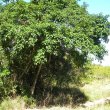
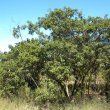
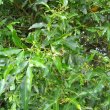

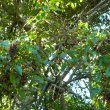
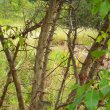


Discuss this plant
Share knowledge, ask a question or give an experience.